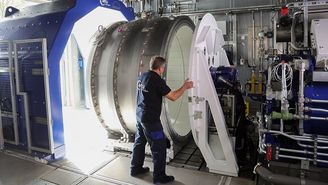
Additive manufacturing
Additive manufacturing
Additive manufacturing (or rapid prototyping) is a promising new manufacturing technology. It involves creating complex components by taking a material in powder form and selectively melting it layer by layer. Examples of additive manufacturing processes are selective laser melting (SLM) and electron beam melting.
Advantages of additive manufacturing
Additive manufacturing has several advantages over conventional manufacturing processes:
- Greater design freedom
- Lower raw material costs
- Shorter turnaround times
Additive manufacturing as a technology of the future
Additive manufacturing is still at the development stage at MTU. One long-term goal is to use additive manufacturing to produce integral honeycomb-structured case sections. These components are currently made from individual brazed sections of sheet metal. Another possible use is in the manufacture of bionically-shaped components which conventional processes have been unable to produce to date.
Selective laser melting
Selective laser melting (SLM) is an additive manufacturing process. The process involves depositing a thin layer of a material in powder form on to a base plate and fully melting (welding) it by selectively applying a laser beam. When it cools down, it forms a solid material layer.
Then the base plate is lowered by the respective layer thickness and more powder is deposited. This goes on until all layers have been fused. Once cleaned, the finished component is ready for use or further processing.
Components manufactured by selective laser melting have a very high density. The mechanical properties of components produced by additive manufacturing processes are largely the same as those of the original material.




